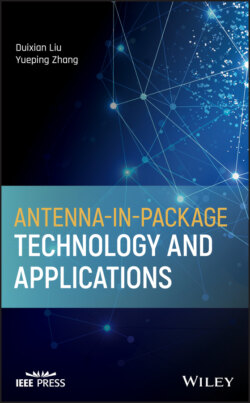Читать книгу Antenna-in-Package Technology and Applications - Duixian Liu - Страница 19
1.3.2 60‐GHz Radio and Other Millimeter‐wave Applications
ОглавлениеIn early March 2005, Zhang met Brian P. Gaucher and Duixian Liu from the IBM Thomas J. Watson Research Center for the first time at the First International Workshop on Small Antenna Technology in Singapore and invited them to visit Nanyang Technological University. Gaucher gave a talk about the IBM 60‐GHz radio SiGe chipsets, antennas, packages, and measurement setup. Figure 1.5 shows the chip‐scale package for proof of concept [24]. The chip‐scale package had a size of 13 × 13 × 1.25 mm3. Note that the radio dies were flip‐chip bonded with the antennas and assembled together as an land grid array (LGA) package. The package required a dedicated opening for an antenna and an encapsulation prior to the mounting of the antenna. Thus, it was difficult to fabricate and assemble this chip‐scale package for mass production. With that in mind, Zhang briefed the visitors about antennas designed for 2.4 and 5 GHz as chip packages in LTCC, and a collaboration plan for a feasibility study for developing LTCC packages embedded with antennas for the IBM 60‐GHz radio SiGe chipset was agreed. Zhang paired up with Mei Sun to lead the design effort, a team of researchers from Singapore Institute of Manufacturing Technology (Chee Wai Lu, Kai Meng Chua, and Lai Lai Wai) was responsible for fabrication, and Duixian Liu did the evaluation and feedback.
Figure 1.5 Photograph of IBM chip‐scale package with integrated chips and antennas.
In June 2005, Naoyuki Shino, Hiroshi Uchimura, and Kentaro Miyazato from the Kyocera research and development center reported the unification of antenna with a package based on laminated waveguides, coupling slots, and open cavity radiating elements in LTCC for short‐range car radar operating in the 77‐GHz band [25].
Even after all of the early attempts at integration of antennas onto or into packages, there is not yet an all‐encompassing term to describe this process. Inspired by SiP, Zhang coined the term AiP to promote the idea [26]. In early March 2006, Zhang attended the Second International Workshop on Small Antenna Technology in New York and visited the IBM Thomas J. Watson Research Center. The visit strengthened the collaboration for integrating antennas in packages and accelerated AiP development. Figure 1.6 shows images captured in the design stage and photos of fabricated AiP samples for IBM 60‐GHz SiGe transmitter and receiver dies. The AiPs for the transmitter and receiver dies measured 12.5 × 8.6 × 1.265 mm3 and 12.5 × 8 × 1.265 mm3, respectively. The transmitter AiP integrated a Yagi‐Uda antenna and the receiver AiP a novel coplanar waveguide (CPW)‐fed quasi‐cavity‐backed, guard‐ring‐directed, substrate‐material‐modulated slot antenna. The measured antenna results were promising and were recognized with the Best Paper Award in the third International Workshop on Small Antenna Technology held on 21–23 March 2007 in Cambridge, UK [27].
In August 2007, Sibeam put the first CMOS 60‐GHz phased array radio in an LTCC AiP [28]. It made board and system design much easier by containing all high‐frequency routing within the CMOS die and chip package, and enabled products in the market for wireless transmission of high‐definition video content. It is worthwhile mentioning that after Zhang's keynote address at the Antenna Systems and Short‐Range Wireless Conference 2005 held on 22–23 September in Santa Clara, California, USA, in the break Zhang enthusiastically discussed some issues about integration of antennas in LTCC with Doan, one of founders of SiBeam and pioneers in mmWave CMOS [29].
